


The song you are hearing is the title track from the movie:
"Trinity and Beyond - The Atomic Bomb Movie"

"If we fight a war and win it with H-bombs, what history will remember
is not the ideals we were fighting for but the methods we used to accomplish them.
These methods will be compared to the warfare of Genghis Khan
who ruthlessly killed every last inhabitant of Persia."
Hans A. Bethe



"...And these atomic bombs which science burst upon the world that night
were strange even to the men who used them."
H. G. Wells, The World Set Free, 1914


Upshot-Knothole
April 18, 1953
The history of nuclear weapons chronicles the development of nuclear weapons—devices of enormous destructive potential which derive their energy from nuclear fission or nuclear fusion reactions—starting with the scientific breakthroughs of the 1930s which made their development possible, continuing through the nuclear arms race and nuclear testing of the Cold War, and finally with the questions of proliferation and possible use for terrorism in the early 21st century.
The first fission weapons ("atomic bombs") were developed in the United States during World War II in what was called the Manhattan Project, at which point two were dropped on Japan. The Soviet Union started development shortly thereafter with their own atomic bomb project, and not long after that both countries developed even more powerful fusion weapons ("hydrogen bombs"). During the Cold War, these two countries each acquired nuclear weapons arsenals numbering in the thousands, placing many of them onto rockets which could hit targets anywhere in the world. Currently there are at least eight countries with functional nuclear weapons. A considerable amount of international negotiating has focused on the threat of nuclear warfare and the proliferation of nuclear weapons to new nations or groups.

Physicist Robert Oppenheimer
By the beginning of World War II, there was concern among scientists in the Allied nations that Nazi Germany might have their own project to develop fission-based weapons. Organized research first began in Britain as part of the "TUBE ALLOYS" project, and in the United States a small amount of funding was given for research into uranium weapons starting in 1939 with the Uranium Committee under Lyman James Briggs. At the urging of British scientists, though, who had made crucial calculations indicating that a fission weapon could be completed within only a few years, by 1941 the project had been wrested into better bureaucratic hands, and in 1942 came under the auspices of General Leslie Groves as the Manhattan Project. Scientifically led by the American physicist Robert Oppenheimer, the project brought together the top scientific minds of the day (many exiles from Europe) with the production power of American industry for the goal of producing fission-based explosive devices before Germany could. Britain and the U.S. agreed to pool their resources and information for the project, but the other Allied power—the Soviet Union under Joseph Stalin—was not informed.
A massive industrial and scientific undertaking, the Manhattan Project involved many of the world's great physicists in the scientific and development aspects. The United States made an unprecedented investment into wartime research for the project, which was spread across over 30 sites in the U.S. and Canada. Scientific knowledge was centralized at a secret laboratory known as Los Alamos, previously a small ranch school near Santa Fe, New Mexico.
Uranium appears in nature primarily in two isotopes: uranium-238 and uranium-235. When the nucleus of uranium-235 absorbs a neutron, it undergoes nuclear fission, splitting into two "fission products" and releasing energy and 2.5 neutrons on average. Uranium-238, on the other hand, absorbs neutrons and does not fission, effectively putting a stop to any ongoing fission reaction. It was discovered that an atomic bomb based on uranium would need to be made of almost completely pure uranium-235 (at least 80% pure), or else the presence of uranium-238 would quickly curtail the nuclear chain reaction. The team of scientists working on the Manhattan Project immediately realized that one of the largest problems they would have to solve was how to remove uranium-235 from natural uranium, which was composed of 99.3% uranium-238. Two methods were developed during the wartime project, both of which took advantage of the fact that uranium-238 has a slightly greater atomic mass than uranium-235: electromagnetic separation and gaseous diffusion—methods which separated isotopes based on their differing weights. Another secret site was erected at rural Oak Ridge, Tennessee, for the large-scale production and purification of the rare isotope. It was a massive investment: at the time, it was the largest factory under one roof, and employed thousands of employees at its peak, most of whom had no idea what they were working on.

Fission Bomb Assembly Methods
Though uranium-238 cannot be used inside an atomic bomb, when it absorbs a neutron it transforms first into an unstable element, uranium-239, and then decays into neptunium-239 and finally the relatively stable plutonium-239, an element which does not exist in nature. Plutonium is also fissile and can be used to create a fission reaction, and after Enrico Fermi achieved the world's first sustained and controlled nuclear chain reaction in the creation of the first "atomic pile"—a primitive nuclear reactor—in a basement at the University of Chicago, massive reactors were secretly created at what is now known as Hanford Site in the state of Washington, using the Columbia River as cooling water, to transform uranium-238 into plutonium for a bomb.
For a fission weapon to operate, there must be a critical mass—the amount needed for a self-sustaining nuclear chain reaction—of fissile material bombarded with neutrons at any one time. The simplest form of nuclear weapon would be a gun-type fission weapon, where a sub-critical mass of fissile material (such as uranium-235) would be shot at another sub-critical mass of fissile material. The result would be a super-critical mass which, when bombarded with neutrons, would undergo fission at a rapid rate and create the desired explosion.
But it was soon discovered that plutonium cannot be used in a "gun assembly," as it has too high a level of background neutron radiation; it undergoes spontaneous fission to a very small extent. If plutonium were used in a "gun assembly," the chain reaction would start in the split seconds before the critical mass was assembled, blowing the weapon apart before it would have any great effect (this is known as a fizzle). After some despair, Los Alamos scientists discovered another approach: using chemical explosives to implode a sub-critical sphere of plutonium, which would increase its density and make it into a critical mass. The difficulties with implosion were in the problem of making the chemical explosives deliver a perfectly uniform shock wave upon the plutonium sphere—if it were even slightly asymmetric, the weapon would fizzle (which would be expensive, messy, and not a very effective military device). This problem was circumvented by the use of hydrodynamic "lenses"—explosive materials of differing densities—which would focus the blast waves inside the imploding sphere, akin to the way in which an optical lens focuses light rays.
After D-Day, General Groves had ordered a team of scientists—Project Alsos—to follow eastward-moving victorious Allied troops into Europe in order to assess the status of the German nuclear program (and to prevent the westward-moving Russians from gaining any materials or scientific manpower). It was concluded that while Nazi Germany had also had an atomic bomb program, headed by Werner Heisenberg, the government had not made a significant investment in the project, and had been nowhere near success.

Trinity
July 16, 1945
World's First Nuclear Explosion
By the unconditional surrender of Germany on May 8, 1945, the Manhattan Project was still months away from a working weapon. That April, after the death of American President Franklin D. Roosevelt, former Vice-President Harry S. Truman was told about the secret wartime project for the first time.
Because of the difficulties in making a working plutonium bomb, it was decided that there should be a test of the weapon, and Truman wanted to know for sure if it would work before his meeting with Joseph Stalin at an upcoming conference on the future of postwar Europe. On July 16, 1945, in the desert north of Alamogordo, New Mexico, the first nuclear test took place, code-named "Trinity," using a device nicknamed "the Gadget." The test released the equivalent of 19 kilotons of TNT, far mightier than any weapon ever used before. The news of the test's success was rushed to Truman, who used it as leverage at the upcoming Potsdam Conference, held near Berlin.
After hearing arguments from scientists and military officers over the possible uses of the weapons against Japan (though some recommended using them as "demonstrations" in unpopulated areas, most recommended using them against "built up" targets, a euphemistic term for populated cities), Truman ordered the use of the weapons on Japanese cities, hoping it would send a strong message which would end in the capitulation of the Japanese leadership and avoid a lengthy invasion of the island. On August 6, 1945, a uranium-based weapon, "Little Boy", was let loose on the Japanese city of Hiroshima. Three days later, a plutonium-based weapon, "Fat Man", was dropped onto the city of Nagasaki. The atomic bombs killed at least one hundred thousand Japanese outright, most of them civilians, with the heat, radiation, and blast effects. Many tens of thousands would die later of radiation sickness and related cancers. Truman promised a "rain of ruin" if Japan did not surrender immediately, threatening to eliminate Japanese cities, one by one; Japan surrendered on August 15. Truman's threat was in fact a bluff, since the US had not completed more atomic bombs at the time.
The weapons had been developed, and their power had been demonstrated to the world. The United States held a monopoly on nuclear weapons, but nobody thought this could last forever—the principles were based in fundamental research, which could be duplicated almost anywhere. The atomic age had begun.

Physicist Edward Teller
The notion of using a fission weapon to ignite a process of nuclear fusion can be dated back to 1942. At the first major theoretical conference on the development of an atomic bomb hosted by J. Robert Oppenheimer at the University of California, Berkeley, participant Edward Teller directed the majority of the discussion towards Enrico Fermi's idea of a "Super" bomb which would utilize the same reactions which powered the Sun itself. It was thought at the time that a fission weapon would be quite simple to develop and that perhaps work on a hydrogen bomb would be possible to complete before the end of the Second World War. However, in reality the problem of a "regular" atomic bomb was large enough to preoccupy the scientists for the next few years, much less the more speculative "Super." Only Teller continued working on the project—against the will of project leaders Oppenheimer and Hans Bethe.
After the atomic bombings of Japan, many scientists at Los Alamos rebelled against the notion of creating a weapon thousands of times more powerful than the first atomic bombs. For the scientists the question was in part technical—the weapon design was still quite uncertain and unworkable—and in part moral: such a weapon, they argued, could only be used against large civilian populations, and could thus only be used as a weapon of genocide. Many scientists, such as Bethe, urged that the United States should not develop such weapons and set an example towards the Soviet Union. Promoters of the weapon, including Teller, Ernest Lawrence, and Luis Alvarez, argued that such a development was inevitable, and to deny such protection to the people of the United States—especially when the Soviet Union was likely to create such a weapon themselves—was itself an immoral and unwise act.
Oppenheimer, who was now head of the General Advisory Committee of the successor to the Manhattan Project, the Atomic Energy Commission, presided over a recommendation against the development of the weapon. The reasons were in part because the success of the technology seemed limited at the time (and not worth the investment of resources to confirm whether this was so), and because Oppenheimer believed that the atomic forces of the United States would be more effective if they consisted of many large fission weapons (of which multiple bombs could be dropped on the same targets) rather than the large and unwieldy predictions of massive super bombs, for which there were a relatively limited amounts of targets of the size to warrant such a development. Furthermore, were such weapons developed by both the U.S. and the USSR, they would be more effectively used against the U.S. than by it, as the U.S. had far more regions of dense industrial and civilian activity which would serve as ideal targets for the large weapons than the Soviet Union did.
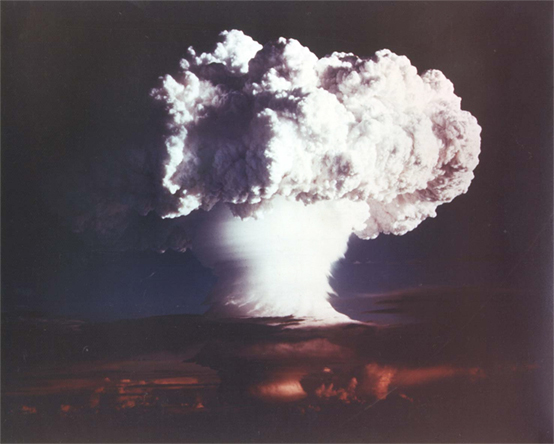
Ivy Mike
November 1, 1952
World's First H Bomb
In the end, President Truman made the final decision, looking for a proper response to the first Soviet atomic bomb test in 1949. On January 31, 1950, Truman announced a crash program to develop the hydrogen (fusion) bomb. At this point, however, the exact mechanism was still not known: the "classical" hydrogen bomb, whereby the heat of the fission bomb would be used to ignite the fusion material, seemed highly unworkable. However, an insight by Los Alamos mathematician Stanislaw Ulam showed that the fission bomb and the fusion fuel could be in separate parts of the bomb, and that radiation of the fission bomb could first work in a way to compress the fusion material before igniting it. Teller pushed the notion further, and used the results of the boosted-fission "George" test (a boosted-fission device using a small amount of fusion fuel to boost the yield of a fission bomb) to confirm the fusion of heavy hydrogen elements before preparing for their first true multi-stage, Teller-Ulam hydrogen bomb test. Many scientists initially against the weapon, such as Oppenheimer and Bethe, changed their previous opinions, seeing the development as being unstoppable.
The first fusion bomb was tested by the United States in Operation Ivy on November 1, 1952, on Elugelab Island in the Enewetak (or Eniwetok) Atoll of the Marshall Islands, code-named "Mike". "Mike" used liquid deuterium as its fusion fuel and a large fission weapon as its trigger. The device was a prototype design and not a deliverable weapon: standing over 20 ft (6 m) high and weighing at least 140,000 lb (64 t) (its refrigeration equipment added an additional 24,000 lb as well), it could not have been dropped from even the largest planes. Its explosion yielded 10.4 megatons of energy—over 450 times the power of the bomb dropped onto Nagasaki— and obliterated Eluegelab, leaving an underwater crater 6240 ft (1.9 km) wide and 164 ft (50 m) deep where the island had once been. Truman had initially tried to create a media blackout about the test—hoping it would not become an issue in the upcoming presidential election—but on January 7, 1953, Truman announced the development of the hydrogen bomb to the world as hints and speculations of it were already beginning to emerge in the press.
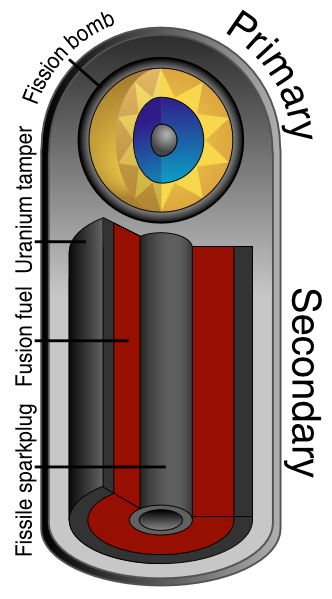
Teller-Ulam Device
The Basics for a Hydrogen Bomb
On February 28, 1954, the U.S. detonated its first deliverable thermonuclear weapon (which used isotopes of lithium as its fusion fuel), known as the "Shrimp" device of the "Castle Bravo" test, at Bikini Atoll, Marshall Islands. The device yielded 15 megatons of energy, over twice its expected yield, and became the worst radiological disaster in U.S. history. The combination of the unexpectedly large blast and poor weather conditions caused a cloud of radioactive nuclear fallout to contaminate over 7,000 square miles, including Marshall Island natives and the crew of a Japanese fishing boat, as a snow-like mist. The contaminated islands were evacuated (and are still uninhabitable), but the natives received enough of a radioactive dose that they suffered far elevated levels of cancer and birth defects in the years to come. The crew of the Japanese fishing boat, Fifth Lucky Dragon, returned to port suffering from radiation sickness and skin burns. Their cargo, many tons of contaminated fish, managed to enter into the market before the cause of their illness was determined. When a crew member died from the sickness and the full results of the contamination were made public by the U.S., Japanese concerns were reignited about the hazards of radiation and resulted in a boycott on eating fish (a main staple of the island country) for some weeks.
The "Castle Bravo" incident itself raised a number of questions about the survivability of a nuclear war. Government scientists in both the U.S. and the USSR had insisted that fusion weapons, unlike fission weapons, were "cleaner" as fusion reactions did not result in the dangerously radioactive by-products as did fission reactions. While technically true, this hid a more gruesome point: the last stage of a multi-staged hydrogen bomb often used the neutrons produced by the fusion reactions to induce fissioning in a jacket of natural uranium, and provided around half of the yield of the device itself. This fission stage made fusion weapons considerably more "dirty" than they were made out to be, a fact made evident by the towering cloud of deadly fallout which followed the "Bravo" test. When the Soviet Union tested its first megaton device in 1955, the possibility of a limited nuclear war seemed even more remote in the public and political mind: even if a city or country was not the direct target of a nuclear attack, the clouds of fallout and harmful fission products would disperse along with normal weather patterns and embed themselves in the soil and water of non-targeted areas of the planet as well. Speculation began to look towards what would happen as the fallout and dust created by a full-scale nuclear exchange would affect the world as a whole, rather than just the cities and countries which had been directly involved. In this way, the fate of the world was now tied to the fate of the bomb-wielding superpowers.
Throughout the 1950s and the early 1960s a number of trends were enacted between the U.S. and the USSR as they both endeavored in a tit-for-tat approach to disallow the other power from acquiring nuclear supremacy. This took form in a number of ways, both technologically and politically, and had massive political and cultural effects during the Cold War.
The first atomic bombs dropped on Hiroshima and Nagasaki were large, custom-made devices, requiring highly trained personnel for their arming and deployment. They could be dropped only from the largest bomber planes—at the time the B-29 Superfortress—and each plane could only hold a single bomb in its hold. The first hydrogen bombs were similarly massive and complicated. This ratio of one plane to one bomb was still fairly impressive in comparison with conventional, non-nuclear weapons, but against other nuclear-armed countries it was considered to be a grave danger. In the immediate postwar years, the U.S. expended much effort on making the bombs "G.I.-proof"—capable of being used and deployed by members of the U.S. Army, rather than Nobel Prize–winning scientists, and in the 1950s a program of nuclear testing was undertaken in order to improve the nuclear arsenal.
Starting in 1951, the Nevada Test Site (in the Nevada desert) became the primary location for all U.S. nuclear testing (in the USSR, Semipalatinsk Test Site in Kazakhstan served a similar role). Tests were divided into two primary categories: "weapons related" (verifying that a new weapon worked or looking at exactly how it worked) and "weapons effects" (looking at how weapons behaved under various conditions or how structures behaved when subjected to weapons). In the beginning, almost all nuclear tests were either "atmospheric" (conducted above ground, in the atmosphere) or "underwater" (such as some of the tests done in the Marshall Islands). Testing was used as a sign of both national and technological strength, but also raised questions about the safety of the tests, which released nuclear fallout into the atmosphere (most dramatically with the Castle Bravo test in 1954, but in more limited amounts with almost all atmospheric nuclear testing).
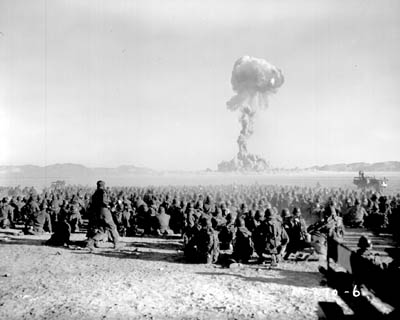
Buster Dog
November, 1951
Because testing was seen as a sign of technological development (the ability to design usable weapons without some form of testing was considered dubious), halts on testing were often called for as stand-ins for halts in the nuclear arms race itself, and many prominent scientists and statesmen lobbied for a ban on nuclear testing. In 1958, the U.S., USSR, and the United Kingdom (a new nuclear power) declared a temporary testing moratorium for both political and health reasons, but by 1961 the Soviet Union had broken the moratorium and both the USSR and the U.S. began testing with great frequency. As a show of political strength, the Soviet Union tested the largest-ever nuclear weapon in October 1961, the massive Tsar Bomba, which was tested in a reduced state with a yield of around 50 megatons—in its full state it was estimated to have been around 100 Mt. The weapon was largely impractical for actual military use, but was hot enough to induce third-degree burns at a distance of 62 mi (100 km) away. In its full, "dirty" design, it would have increased the amount of worldwide fallout since 1945 by 25%.
In 1963, all nuclear and many non-nuclear states signed the Limited Test Ban Treaty, pledging to refrain from testing nuclear weapons in the atmosphere, underwater, or in outer space. The treaty permitted underground tests.
Most tests were considerably more modest, and worked for direct technical purposes as well as their potential political overtones. Weapons improvements took on two primary forms. One was an increase in efficiency and power, and within only a few years fission bombs were being developed which were many times more powerful than the ones created during World War II. The other was a program of miniaturization, reducing the size of the nuclear weapons themselves. Smaller bombs meant that bombers could carry more of them, and thus become even more of a threat against even the most rigorous air defenses, and they could also be used in conjunction with the development in rocketry during the 1950s and 1960s. U.S. rocket efforts had received a large boost in the postwar years, largely from the acquiring of engineers who had worked on the Nazi rocketry program during the war, such as Wernher von Braun, who had been involved in the design and manufacture of the V-2 rockets which were launched across the English Channel. An American program, Project Paperclip, had endeavored to move scientists of this sort into American hands (and kept out of Soviet hands) and put them to work on projects for the U.S.
Bombers and short-range rockets were not reliable: planes could be shot down, and earlier nuclear missiles could cover only a limited range— for example, the first Soviet rockets' range limited them to targets in Europe. However, by the 1960s, both the United States and the Soviet Union had developed intercontinental ballistic missiles, which could be launched from extremely remote areas far away from their target; and submarine-launched ballistic missiles, which had less range but could be launched from submarines very close to the target without any radar warning. This made any national protection from nuclear missiles increasingly impractical.
The military realities made for a precarious diplomatic situation. The international politics of brinkmanship led leaders to exclaim their willingness to participate in a nuclear war rather than concede any advantage to their opponents, feeding public fears that their generation may be the last. Civil defense programs undertaken by both superpowers, exemplified by the construction of fallout shelters and urging civilians about the "survivability" of nuclear war, did little to ease public concerns. A joke known by most Russians during the Cold War said that when one heard the air raid sirens, one should pick up a shovel and quietly proceed to the nearest cemetery, to dig your own grave. A similar joke in the U.S. recommended that one stay calm, put one's head between one's legs, and kiss your ass goodbye, a parody of the "duck and cover" routines practiced by schoolchildren across the country.
The climax of brinksmanship came in early 1962, when an American U-2 spy plane photographed a series of launch sites for medium-range ballistic missiles being constructed on the island of Cuba, just off the coast of the southern United States, beginning what became known as the Cuban Missile Crisis. The U.S. administration of John F. Kennedy concluded that the Soviet Union, then led by Nikita Khrushchev, was planning to station Russian nuclear missiles on the island, which was under the control of Communist Fidel Castro. On October 22, Kennedy announced the discoveries in a televised address, and declared that a naval quarantine would be put around Cuba to turn back any Soviet nuclear shipments, and warned that the military was prepared "for any eventualities." The missiles would have a range of 2,400 miles (4,000 km), and allow the Soviet Union to easily destroy many major American cities on the Eastern Seaboard if a nuclear war were started.
The leaders of the two superpowers stood nose to nose, seemingly poised over the beginnings of a third world war. Khrushchev's ambitions for putting the weapons on the island were motivated in part by the fact that the U.S. had stationed similar weapons in Britain, Italy, and nearby Turkey, and had previously attempted to sponsor an invasion of Cuba the year before in the failed Bay of Pigs Invasion. On October 26, an offer was sent from Khrushchev to Kennedy offering to withdraw all missiles if Kennedy would commit to a policy of no future invasions of Cuba. Khrushchev worded the threat of assured destruction eloquently:
- "You and I should not now pull on the ends of the rope in which you have tied a knot of war, because the harder you and I pull, the tighter the knot will become. And a time may come when this knot is tied so tight that the person who tied it is no longer capable of untying it, and then the knot will have to be cut. What that would mean I need not explain to you, because you yourself understand perfectly what dreaded forces our two countries possess."
A day later, however, the Russians put forward another offer, this time demanding that the U.S. remove its missiles from Turkey before any missiles would be withdrawn from Cuba. On the same day, a U-2 plane was shot down over Cuba and another was almost intercepted over Russia, and Soviet merchant ships were nearing the quarantine zone. Kennedy responded by accepting the first deal publicly, and sending his brother Robert to the Soviet embassy to accept the second deal in private. On October 28, the Soviet ships stopped at the quarantine line and, after some hesitation, turned back towards the Soviet Union. Khrushchev announced that he had ordered the removal of all missiles in Cuba, and U.S. Secretary of State Dean Rusk was moved to comment, "We went eyeball to eyeball, and the other fellow just blinked."
The Crisis was later seen as the closest the U.S. and the USSR ever came to nuclear war and had been narrowly averted by last-minute compromise by both superpowers. Fears of communication difficulties led to the installment of the first hotline, a direct link between the superpowers which would allow them to more easily discuss future military activities and political maneuverings. It had been made clear that with their missiles, bombers, submarines, and computerized firing systems, the escalation of any situation to Armageddon could be done far easier than anybody desired.
After stepping so close to the brink, both the U.S. and the USSR worked to reduce their nuclear tensions in the years immediately following. The most immediate culmination of this work was the signing of the Partial Test Ban Treaty in 1963, in which the U.S. and USSR agreed to no longer test nuclear weapons in the atmosphere, underwater, or in outer space. Testing underground continued, allowing for further weapons development, but the worldwide fallout risks were purposefully reduced, and the era of using massive nuclear tests as a form of saber rattling had primarily ended.
In 1981, as U.S. President Ronald Reagan's administration pushed the arms race to new levels of higher tension with the USSR, one million people marched for nuclear disarmament and abolition in New York City. As the nuclear abolitionist movement grew, over 2,000 people were arrested in a two-day period in 1988 at the gate of the Nevada Test Site. Four of the significant groups organizing this renewal of anti-nuclear activism were Greenpeace, The American Peace Test, The Western Shoshone, and Nevada Desert Experience. Nevada Desert Experience (NDE) had kickstarted the renewal in 1982, and maintained annual resistance and prayer-actions for peace in Western Shoshone country (within Nevada) for 25 years.
The United Kingdom had been an integral part of the Manhattan Project following the Quebec Agreement in 1943. The passing of the McMahon Act by the United States in 1946 unilaterally broke this partnership and prevented the passage of any further information to the United Kingdom. The British Government under Clement Attlee determined that it would be essential for there to be a British Bomb. Because of the involvement in the Manhattan Project Britain had extensive knowledge in some areas, but not in others. An improved version of 'Fat Man' was developed, and on 26th February 1952, Prime Minister Winston Churchill announced that the United Kingdom also had an atomic bomb and a successful test took place on the 3rd October 1952. At first these were free-fall bombs and then there was a missile, Blue Steel, and a later-cancelled MRBM, Blue Streak. Anglo-American cooperation on Nuclear weapons was restored by the 1958 US-UK Mutual Defence Agreement. As a result of this and the Polaris Sales Agreement, the United Kingdom has bought United States designs for submarine missiles and fitted its own warheads. It retains full independent control over the use of the missiles. It no longer possesses any free-fall bombs.
France had been heavily involved in nuclear research before World War II through the work of the Joliot-Curies. This was discontinued after the war because of the instability of the Fourth Republic and the lack of finance available[2]. However, in the 1950's a civil nuclear research programme was started, a byproduct of which would be plutonium. In 1956 a secret Committee for the Military Applications of Atomic Energy was formed and a development programme for delivery vehicles started. With the return of Charles de Gaulle to the presidency of France in 1958 the final decisions to build a bomb were taken, and a successful test took place in 1960. Since then France has developed and maintained its own nuclear deterrent.
In 1951 China and the Soviet Union signed an agreement whereby China would supply uranium ore in exchange for technical assistance in producing nuclear weapons. In 1953 China had established a research programme under the guise of civilian nuclear energy. Throughout the 1950's the Soviet Union provided large amounts of equipment, but as the relations between the two countries worsened, the amount of assistance was reduced, and in 1959 the donation of a bomb for copying purposes was refused. Despite this, rapid progress was made with the test of an atomic bomb on the 16th October 1964 at Lop Nur, a nuclear missile on 25th October 1966, and of a hydrogen bomb on the 14th June 1967. Nuclear warheads were produced from 1968 and thermonuclear warheads from 1974. The Cultural Revolution slowed the pace of progress, but it is thought that tactical nuclear weapons have been developed. It is also thought that Chinese warheads have been successfully miniaturised from 2200kg to 700kg through the use of designs obtained by espionage from the United States. The current number of weapons is unknown owing to strict secrecy, but it is thought that up to 2000 warheads may have been produced, though far fewer may be available for use. China is the only one of the Nuclear Weapons States to have guaranteed the non-first use of nuclear weapons.
After World War II, the balance of power between the Eastern and Western blocs, resulting in the fear of global destruction, prevented the further military use of atomic bombs. This fear was even a central part of Cold War strategy, referred to as the doctrine of Mutually Assured Destruction ("MAD" for short). So important was this balance to international political stability that a treaty, the Anti-Ballistic Missile Treaty (or ABM treaty), was signed by the U.S. and the USSR in 1972 to curtail the development of defenses against nuclear weapons and the ballistic missiles which carry them. This doctrine resulted in a large increase in the number of nuclear weapons, as each side sought to ensure it possessed the firepower to destroy the opposition in all possible scenarios and against all perceived threats.
Early delivery systems for nuclear devices were primarily bombers like the United States B-29 Superfortress and Convair B-36, and later the B-52 Stratofortress. Ballistic missile systems, based on Wernher von Braun's World War II designs (specifically the V2 rocket), were developed by both United States and Soviet Union teams (in the case of the U.S., effort was directed by the German scientists and engineers). These systems, after testing, were used to launch satellites, such as Sputnik, and to propel the Space Race, but they were primarily developed to create the capability of Intercontinental Ballistic Missiles (ICBMs) with which nuclear powers could deliver that destructive force anywhere on the globe. These systems continued to be developed throughout the Cold War, although plans and treaties, beginning with the Strategic Arms Limitation Treaty (SALT I), restricted deployment of these systems until, after the fall of the Soviet Union, system development essentially halted, and many weapons were disabled and destroyed (see nuclear disarmament).

LGM-30 Minuteman III
Intercontinental Ballistic Missile (ICBM)
There have been a number of potential nuclear disasters. Following air accidents U.S. nuclear weapons have been lost near Atlantic City, New Jersey (1957); Savannah, Georgia (1958) (see Tybee Bomb); Goldsboro, North Carolina (1961); off the coast of Okinawa (1965); in the sea near Palomares, Spain (1966); and near Thule, Greenland (1968). Most of the lost weapons were recovered, the Spanish device after three months' effort by the DSV Alvin and DSV Aluminaut. The Soviet Union was less forthcoming about such incidents, but the environmental group Greenpeace believes that there are around forty non-U.S. nuclear devices that have been lost and not recovered, compared to eleven lost by America, mostly in submarine disasters. The U.S. has tried to recover Soviet devices, notably in the 1974 Operation Jennifer using the specialist salvage vessel Hughes Glomar Explorer.
On January 27, 1967, more than 60 nations signed the Outer Space Treaty, banning nuclear weapons in space.
The end of the Cold War failed to end the threat of nuclear weapon use, although global fears of nuclear war reduced substantially.
In a major move of de-escalation, Boris Yeltsin, on January 26, 1992, announced that Russia planned to stop targeting United States cities with nuclear weapons.
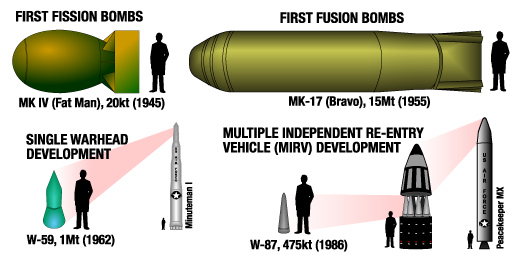
Nuclear Weapon Size Chart
India's first atomic-test explosion was in 1974 with Smiling Buddha, which it described as a "peaceful nuclear explosion". India tested fission and perhaps fusion devices in 1998, and Pakistan successfully tested fission devices that same year, raising concerns that they would use nuclear weapons on each other. All of the former Soviet bloc countries with nuclear weapons (Belarus, Ukraine, and Kazakhstan) returned their warheads to Russia by 1996, though recent data has suggested that a clerical error may have left some warheads in Ukraine.
In January 2004, Pakistani metallurgist and weapons scientist Abdul Qadeer Khan confessed to having been a part of an international proliferation network of materials, knowledge, and machines from Pakistan to Libya, Iran, and North Korea.
South Africa also had an active program to develop uranium-based nuclear weapons, but dismantled its nuclear weapon program in the 1990s. It is not believed that it actually tested such a weapon though it later claimed to have constructed several crude devices which it eventually dismantled. In the late 1970s American spy satellites detected a "brief, intense, double flash of light near the southern tip of Africa." [3] which was speculated to have been a South African nuclear weapons test, though a later scientific review of the data indicated that it may have been caused by natural events.
Israel is widely believed to possess an arsenal of potentially up to several hundred nuclear warheads, but this has never been officially confirmed or denied (though the existence of their Dimona nuclear facility was more or less confirmed by the leaks of the dissident Mordechai Vanunu in 1986).
North Korea announced in 2003 that it also had several nuclear explosives though it has not been confirmed and the validity of this has been a subject of scrutiny amongst weapons experts. The first detonation of a nuclear weapon by the Democratic People's Republic of Korea was the 2006 North Korean nuclear test, conducted on October 9, 2006.
In Iran, Ayatollah Ali Khamenei issued a fatwa forbidding the production, stockpiling and use of nuclear weapons on August 9, 2005. The full text of the fatwa was released in an official statement at the meeting of the International Atomic Energy Agency (IAEA) in Vienna. [4] Despite this, however, there is mounting concern in many nations about Iran's refusal to halt its nuclear power program, which many fear is a cover for weapons development. Some are especially concerned in light of statements by Iranian President Mahmoud Ahmadinejad indicating his desire to completely annihilate the nation of Israel.

Animated map of all things nuclear in the USA - 1941 to 2004

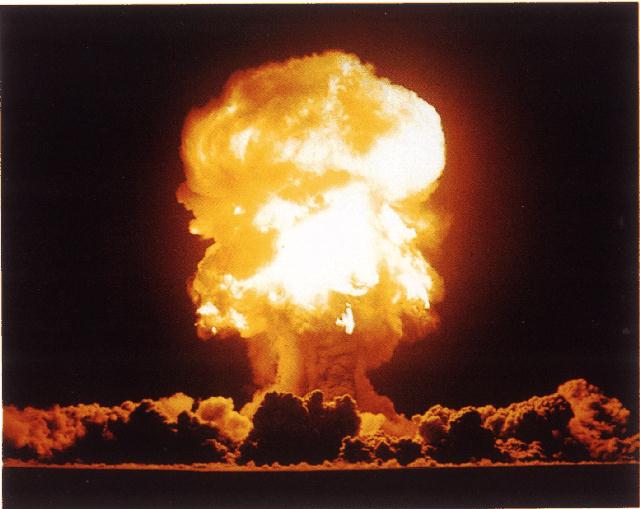


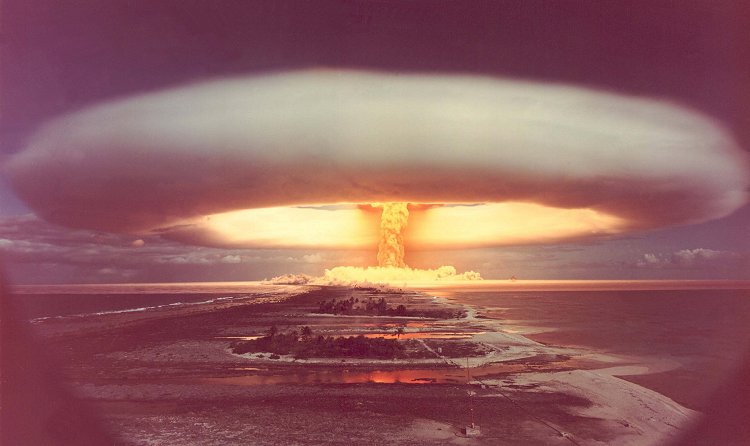
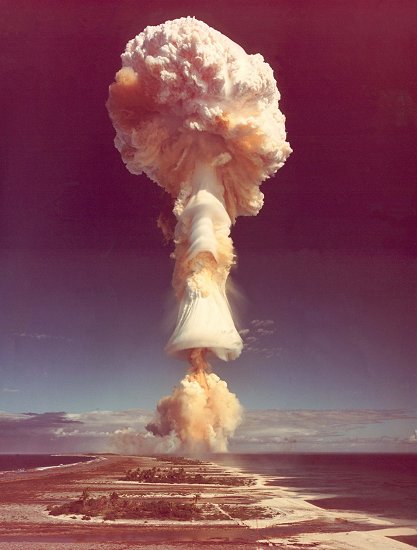
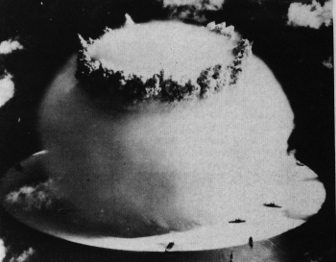
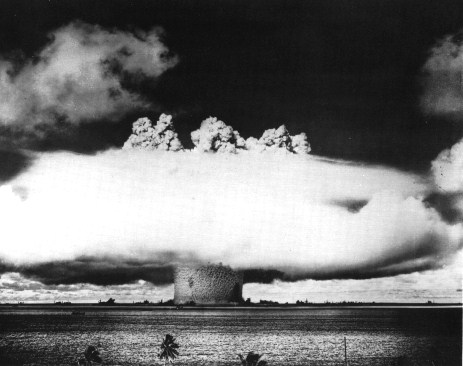
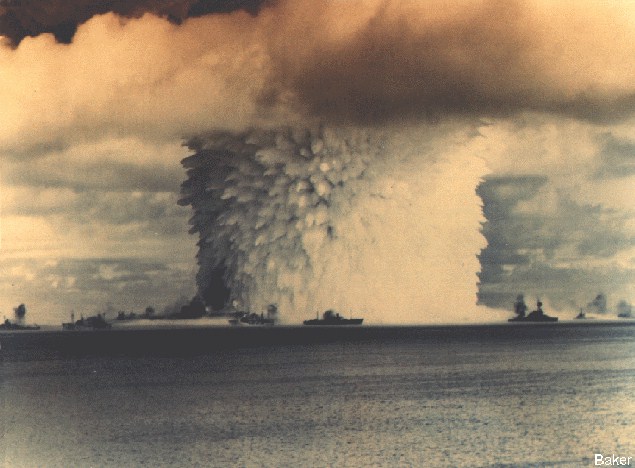

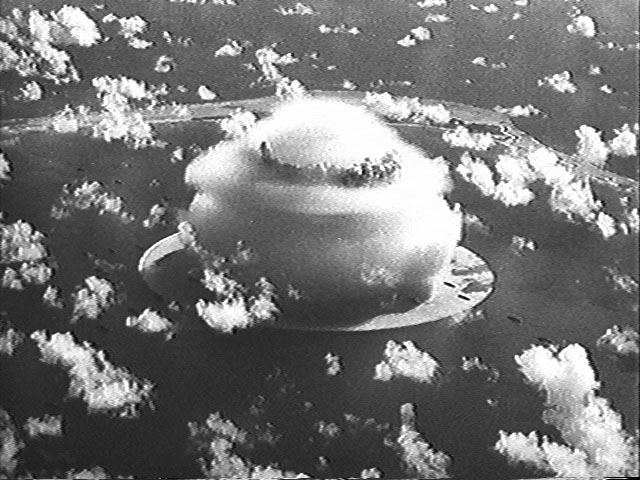

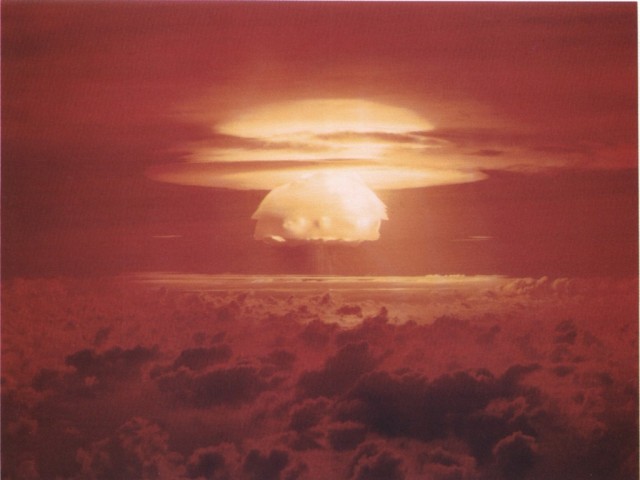
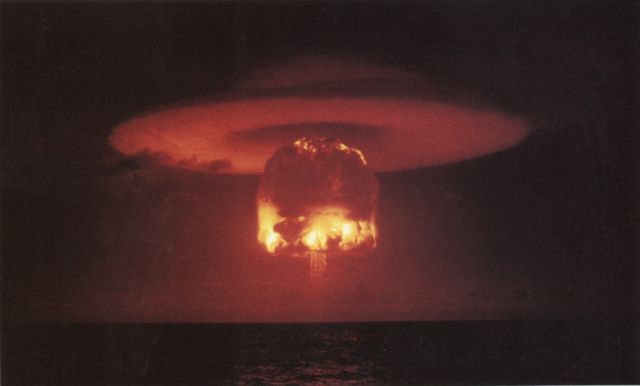



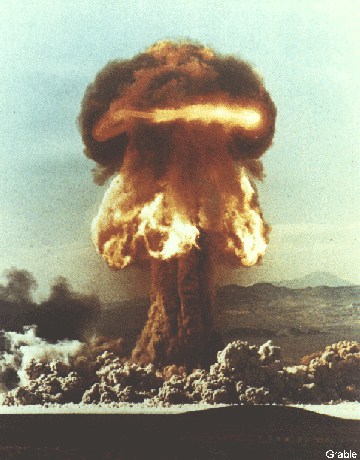
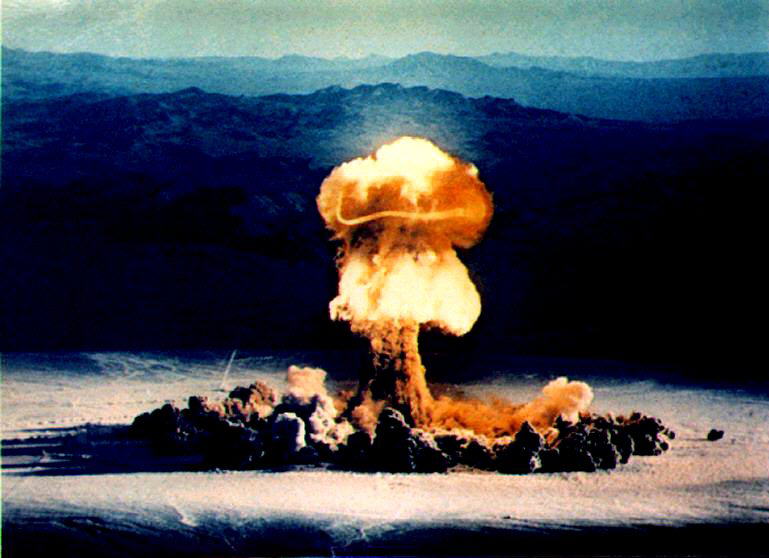
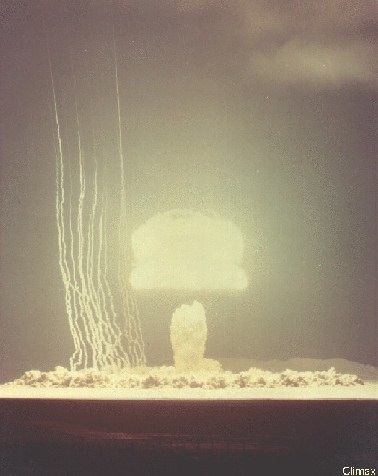

Trinity Crater

THE
EFFECTS OF NUCLEAR WEAPONS
By Russell D. Hoffman
Copyright (c) 1999
(Pictures are from U.S. Government sources.)
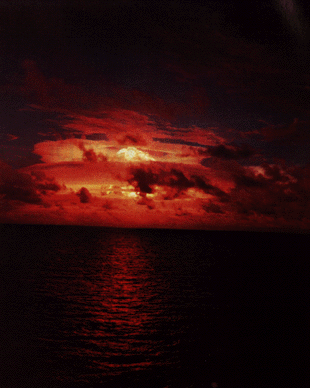 A
year ago this month (May, 1999), India surprised the CIA -- and nearly everyone
else except, perhaps, Pakistan, who seems to have been nearly ready -- by setting
off several underground nuclear explosions. Then Pakistan, claiming self-defense,
followed suit. But what would actually happen if India and Pakistan had a nuclear
exchange?
A
year ago this month (May, 1999), India surprised the CIA -- and nearly everyone
else except, perhaps, Pakistan, who seems to have been nearly ready -- by setting
off several underground nuclear explosions. Then Pakistan, claiming self-defense,
followed suit. But what would actually happen if India and Pakistan had a nuclear
exchange?
Most people in India and in Pakistan (and in the U.S.) probably do not know that as many as 9 out of 10 people -- or more -- who die from a nuclear blast, do not die in the explosion itself. Most people probably think that if they die from a nuclear blast, they will simply see a flash and get quickly cooked.
Those within approximately a six square mile area (for a 1 megaton blast) will indeed be close enough to "ground zero" to be killed by the gamma rays emitting from the blast itself. Ghostly shadows of these people will be formed on any concrete or stone that lies behind them, and they will be no more. They literally won't know what hit them, since they will be vaporized before the electrical signals from their sense organs can reach their brains.
Of the many victims of a nuclear war, these are the luckiest ones, of course.
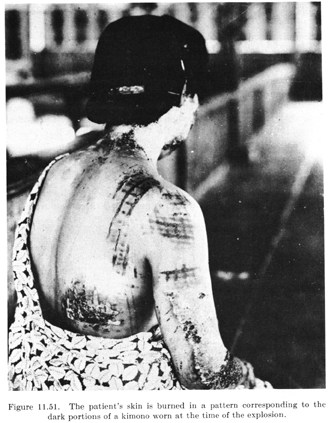 Outside
the circle where people will be instantly vaporized from the initial gamma radiation
blast, the light from the explosion (which is many times hotter than the sun)
is so bright that it will immediately and permanently blind every living thing,
including farm animals (including cows, sacred or otherwise), pets, birds while
in flight and not to mention peasants, Maharajah's, and Government officials --
and soldiers, of course. Whether their eyes are opened or closed. This will happen
for perhaps 10 miles around in every direction (for a 1 megaton bomb) -- further
for those who happen to be looking towards the blast at the moment of detonation.
Even from fifty miles away, a 1 megaton blast will be many times brighter than
the noonday sun. Those looking directly at the blast will have a large spot permanently
burned into their retinas, where the light receptor cells will have been destroyed.
The huge bright cloud being nearly instantly formed in front of them (made in
part from those closer to the blast, who have already "become death"), will be
the last clear image these people will see.
Outside
the circle where people will be instantly vaporized from the initial gamma radiation
blast, the light from the explosion (which is many times hotter than the sun)
is so bright that it will immediately and permanently blind every living thing,
including farm animals (including cows, sacred or otherwise), pets, birds while
in flight and not to mention peasants, Maharajah's, and Government officials --
and soldiers, of course. Whether their eyes are opened or closed. This will happen
for perhaps 10 miles around in every direction (for a 1 megaton bomb) -- further
for those who happen to be looking towards the blast at the moment of detonation.
Even from fifty miles away, a 1 megaton blast will be many times brighter than
the noonday sun. Those looking directly at the blast will have a large spot permanently
burned into their retinas, where the light receptor cells will have been destroyed.
The huge bright cloud being nearly instantly formed in front of them (made in
part from those closer to the blast, who have already "become death"), will be
the last clear image these people will see.
Most people who will die from the nuclear explosion will not die in the initial gamma ray burst, nor in the multi-spectral heat blast (mostly X-ray and ultraviolet wavelengths) which will come about a tenth of a second after the gamma burst. Nor will the pressure wave which follows over the next few seconds do most of them in, though it will cause bleeding from every orifice. Nor even will most people be killed by the momentary high winds which accompany the pressure wave. These winds will reach velocities of hundreds of miles an hour near the epicenter of the blast, and will reach velocities of 70 miles per hour as far as 6 miles from the blast (for a 1 megaton bomb). The high winds and flying debris will cause shrapnel-type wounds and blunt-trauma injuries.
Together, the pressure wave and the accompanying winds will do in quite a few, and damage most of the rest of the people (and animals, and structures) in a huge circle -- perhaps hundreds of square miles in area.
Later, these people will begin to suffer from vomiting, skin rashes, and an intense unquenchable thirst as their hair falls out in clumps. Their skin will begin to peel off. This is because the internal molecular structure of the living cells within their bodies is breaking down, a result of the disruptive effects of the high radiation dose they received. All the animals will be similarly suffering. Since they have already received the dose, these effects will show up even if the people are immediately evacuated from the area -- hardly likely, since everything around will be destroyed and the country would be at war.
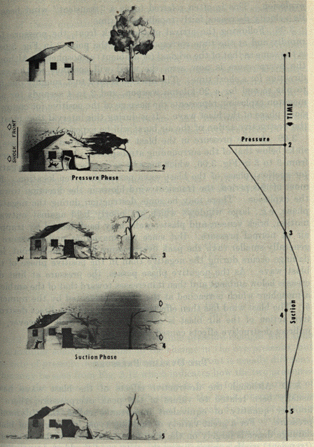 But this
will not concern them at this time: Their immediate threat after the gamma blast,
heat blast, pressure wave and sudden fierce wind (first going in the direction
of the pressure wave -- outwardly from the blast -- then a moment later, a somewhat
weaker wind in the opposite direction), will be the firestorm which will quickly
follow, with its intense heat and hurricane-force winds, all driving towards the
center where the radioactive mushroom-shaped cloud will be rising, feeding it,
enlarging it, and pushing it miles up into the sky.
But this
will not concern them at this time: Their immediate threat after the gamma blast,
heat blast, pressure wave and sudden fierce wind (first going in the direction
of the pressure wave -- outwardly from the blast -- then a moment later, a somewhat
weaker wind in the opposite direction), will be the firestorm which will quickly
follow, with its intense heat and hurricane-force winds, all driving towards the
center where the radioactive mushroom-shaped cloud will be rising, feeding it,
enlarging it, and pushing it miles up into the sky.
The cloud from a 1 megaton blast will reach nearly 10 miles across and equally high. Soon after forming, it will turn white because of water condensation around it and within it. In an hour or so, it will have largely dissipated, which means that its cargo of death can no longer be tracked visually. People will need to be evacuated from under the fallout, but they will have a hard time knowing where to go. Only for the first day or so will visible pieces of fallout appear on the ground, such as marble-sized chunks of radioactive debris and flea-sized dots of blackened particles. After that the descending debris from the radioactive cloud will become invisible and harder to track; the fallout will only be detectible with geiger counters carried by people in "moon suits". But all the moon suits will already be in use in the known affected area. Probably, no one will be tracking the cloud. One U.S. test in the South Pacific resulted in a cigar-shaped contamination area 340 miles long and up to 60 miles wide. It spread 20 miles *upwind* from the test site, and 320 miles downwind. Where exactly it goes all depends on the winds and the rains at the time. It is difficult to predict where the cloud will travel before it happens, and it is likewise difficult to track the cloud as it moves and dissipates around the globe. While underground testing is bad enough for the environment, a single large above-ground explosion is likely to result in measurable global increases of a whole spectrum of health effects. India or Pakistan will deny culpability for these deaths, of course. The responsible nations, including my own, always do.
But the people who were affected by the blast itself will not be worrying about the fallout just yet.
A 1 megaton nuclear bomb creates a firestorm that can cover 100 square miles. A 20 megaton blast's firestorm can cover nearly 2500 square miles. Hiroshima and Nagasaki were small cities, and by today's standards the bombs dropped on them were small bombs.
The Allied firebombing of nearly 150 cities during World War Two in Germany and Japan seldom destroyed more than 25 square miles at a time, and each of those raids required upwards of 400 planes, and thousands of crewmembers going into harm's way. It was not done lightly. And, they did not leave a lingering legacy of lethal radioactive contamination.
In the span of a lunch hour, one multi-warhead nuclear missile can destroy more cities than all the incendiary raids in history, and the only thing the combatant needs to do to carry off such a horror is to sit in air-conditioned comfort hundreds or even thousands of miles away, and push a button. He would barely have to interrupt his lunch. With automation, he wouldn't even have to do that! The perpetrator of this crime against humanity may never have seen his adversary. He only needs to be good at following the simplest of orders. A robot could do it. One would think, that ONLY a robot WOULD do it.
Nuclear war is never anything less than genocide.
The developing firestorm is what the survivors of the initial blast will be worrying about -- if they can think straight at all. Many will have become instantly "shell-shocked" -- incapacitated and unable to proceed. Many will simply go mad. Perhaps they are among the "lucky" ones, as well.
The firestorm produces hurricane-force winds in a matter of minutes. The fire burns so hot that the asphalt in the streets begins to melt and then burn, even as people are trying to run across it, literally melting into the pavement themselves as they run. Victims, on fire, jump into rivers, only to catch fire again when they surface for air. Yet it is hard to see even these pitiable souls as the least lucky ones in a nuclear attack.
For the survivors of the initial blast who do not then die in the firestorm that follows, many will die painfully over the next few weeks, often after a brief, hopeful period where they appear to be getting better. It might begin as a tingling sensation on the skin, or an itching, which starts shortly after the blast. These symptoms are signs that the body is starting to break down internally, at the molecular level. The insides of those who get a severe dose of gamma radiation, but manage to survive the other traumas, whose organs had once been well defined as lungs, liver, heart, intestines, etc., begin to resemble an undefined mass of bloody pulp. Within days, or perhaps weeks, the victim, usually bleeding painfully from every hole and pore in their body, at last dies and receives their final mercy.
But this too will probably not be how most victims of a nuclear attack will die.
A significant percentage, probably most, of the people who die from a nuclear attack will die much later, from the widespread release of radioactive material into the environment. These deaths will occur all over the world, for centuries to come. Scattered deaths, and pockets of higher mortality rates, will continue from cancer, leukemia, and other health effects, especially genetic damage to succeeding generations.
Nuclear weapons do not recognize the end of a war, or signed peace treaties, or even the deaths of all the combatants. They simply keep on killing a percentage of whoever happens to inhale or ingest their deadly byproducts.
Some deaths will occur hundreds and even thousands of miles away, because low levels of ionizing radiation are capable of causing the full spectrum of health effects, albeit at a lower rate within the population. Not to mention the radioactive runoff from the rivers and streams that flow through the blast area and the area under the radioactive mushroom cloud's drift. It may carry its deadly cargo for thousands of miles, raining a fallout of death only on some cities, and not on others. It will land upon nations which had not been involved in any way in India's dispute with Pakistan. These nations will be mighty hurt and mighty upset.
Nuclear weapons do not recognize international borders.
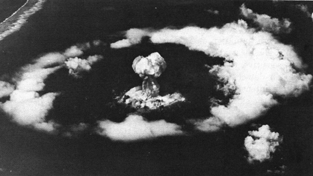 Finally,
an atmospheric blast of a nuclear "device" creates an EMP (Electro-Magnetic Pulse)
which can be as large as Pakistan or even India -- perhaps even larger than India
and Pakistan together. The higher the altitude of the blast, the bigger the circle
of damage will be from the EMP. This is a very serious concern for those of us
in the high-tech industries, such as myself.
Finally,
an atmospheric blast of a nuclear "device" creates an EMP (Electro-Magnetic Pulse)
which can be as large as Pakistan or even India -- perhaps even larger than India
and Pakistan together. The higher the altitude of the blast, the bigger the circle
of damage will be from the EMP. This is a very serious concern for those of us
in the high-tech industries, such as myself.
The Electro-Magnetic Pulse will electrify all sorts of metallic structures that are not normally electrified except by the occasional short circuit or lightening strike. This will be a lot like the whole country getting struck by lightening all at the same time.
As computer chips make better and better use of "real estate", using more and more delicate electronic circuits, the more tightly-packed transistors, capacitors, diodes and resistors become more and more vulnerable to the EMP which will be carried into the chips via the connecting wires. The Electro-Magnetic Pulse is one of the reasons above-ground testing was stopped. (The other reason was that it became impossible to deny that the radiation dispersed by the tests was killing people.)
Pacemakers, for example, may stop working because of the "hit" from the EMP. It will be quite something to see people in a thousand mile radius of the epicenter of the blast (or further) who are using pacemakers, suddenly drop dead, and all the computers permanently go down and all the lights go out, all at the same time. And commercial and private aircraft will drop out of the sky, since their sensitive electronics and fly-by-wire systems are not very well shielded from the EMP. These planes will then not be available for evacuation purposes, nor will they be available to air-drop food, water, morphine and cyanide, all of which will be in great demand throughout the area.
A year ago people were dancing in the streets over this in both India and Pakistan. Why?
Home plumbing systems and most other plumbing systems are good examples of large metallic structures that will suddenly become electrified, destroying the motors, gauges, electronics, etc. which are attached to the plumbing systems. More and more pumping equipment is computer controlled nowadays for efficiency. Imbedded controllers are becoming prevalent but as they do, the potential damage from the Electro-Magnetic Pulse increases dramatically.
Train tracks will also carry the charge, as well as telephone wiring. All these things will have a nearly simultaneous surge of energy sent through them, igniting gas containers such as fuel storage tanks, propane tanks, and so on. Whatever doesn't blow up will at least stop working.
My country has lived under the Russian and Chinese threat of nuclear war for many decades now, and it is not a pleasant thought. This is nothing to dance about. There is no benefit to having, or using, nuclear weapons.
I think the world would be a better place if we all stopped and said, "I will not be a part of this. I do not need these weapons, for I would never commit this sin against my own children, nor against my neighbor's children, nor against my enemy's children, nor even against my enemy. I choose not to be a part of this madness."
There is a greater battle mankind must fight than against each other. Humanity's fight right now, is for humanity's general survival despite depleted and poorly used resources, environmental degradation (there is none greater than that from a nuclear explosion), dwindling effectiveness of antibiotics and other wonder drugs, an uneven distribution of available food, knowledge and wealth, and against weapons of mass destruction.
America had three excuses for her previous use of nuclear weapons in war, which we plead every time it is mentioned. First, we claim that we did not understand back then (over 50 years ago) all the ways nuclear weapons damage the Earth and her living inhabitants. Second, we claim that there was a war going on, and that had we not used these weapons, perhaps a million soldiers would have died invading Japan instead. But this second excuse is weakened by the knowledge that Japan was at that time very near collapse anyway. She was without an air defense, a sea defense, she did not have advanced radar, she had lost all her good pilots, millions of soldiers were either dead, wounded, captured, or uselessly stuck on nameless islands in the middle of the Pacific, and towns in her homeland were being firebombed on almost a nightly basis.
Our third excuse was that both Japan (and definitely Germany) were building their own nuclear weapons, and DEFINITELY would have used them against us had they succeeded in developing "the bomb" before the war ended. The war could not go on forever. We were, indeed, running out of time.
Perhaps these excuses are insufficient, but India and Pakistan haven't even got them. India can, and therefore should, along with Pakistan, renounce nuclear weapons and the nuclear option. Perhaps her populace does not understand the full nature of the threat of nuclear weapons, and thus they are dancing in the streets, but I hope that her leaders do. However, I strongly suspect most of them are unaware of the things I have written about in this newsletter. Perhaps you, dear reader, will help me to educate them in this matter.
Sincerely,
Russell D. Hoffman
Carlsbad, California

Nuclear Fission: Basics
When a nucleus fissions, it splits into several smaller fragments. These fragments, or fission products, are about equal to half the original mass. Two or three neutrons are also emitted.

Nuclear Fission
The sum of the masses of these fragments is less than the original mass. This 'missing' mass (about 0.1 percent of the original mass) has been converted into energy according to Einstein's equation.
Fission can occur when a nucleus of a heavy atom captures a neutron, or it can happen spontaneously.

Nuclear Fusion

Nuclear Fusion
Nuclear energy can also be released by fusion of two light elements (elements with low atomic numbers). The power that fuels the sun and the stars is nuclear fusion. In a hydrogen bomb, two isotopes of hydrogen, deuterium and tritium are fused to form a nucleus of helium and a neutron. This fusion releases 17.6 MeV of energy. Unlike nuclear fission, there is no limit on the amount of the fusion that can occur.

My thanks to "Wikipedia", "The Nuclear Weapon Archive" and "atomicarchive.com" for much of the content on this page.
DVD's for purchase at "atomicarchive.com"
Video clips of the effects of nuclear explosions, from "atomicarchive.com"
Cold War: A Brief History, from "atomicarchive.com"

"No one who saw it could forget it, a foul and awesome display."
Kenneth Bainbridge, physicist

©2006 Ralph A. Gambino Jr.